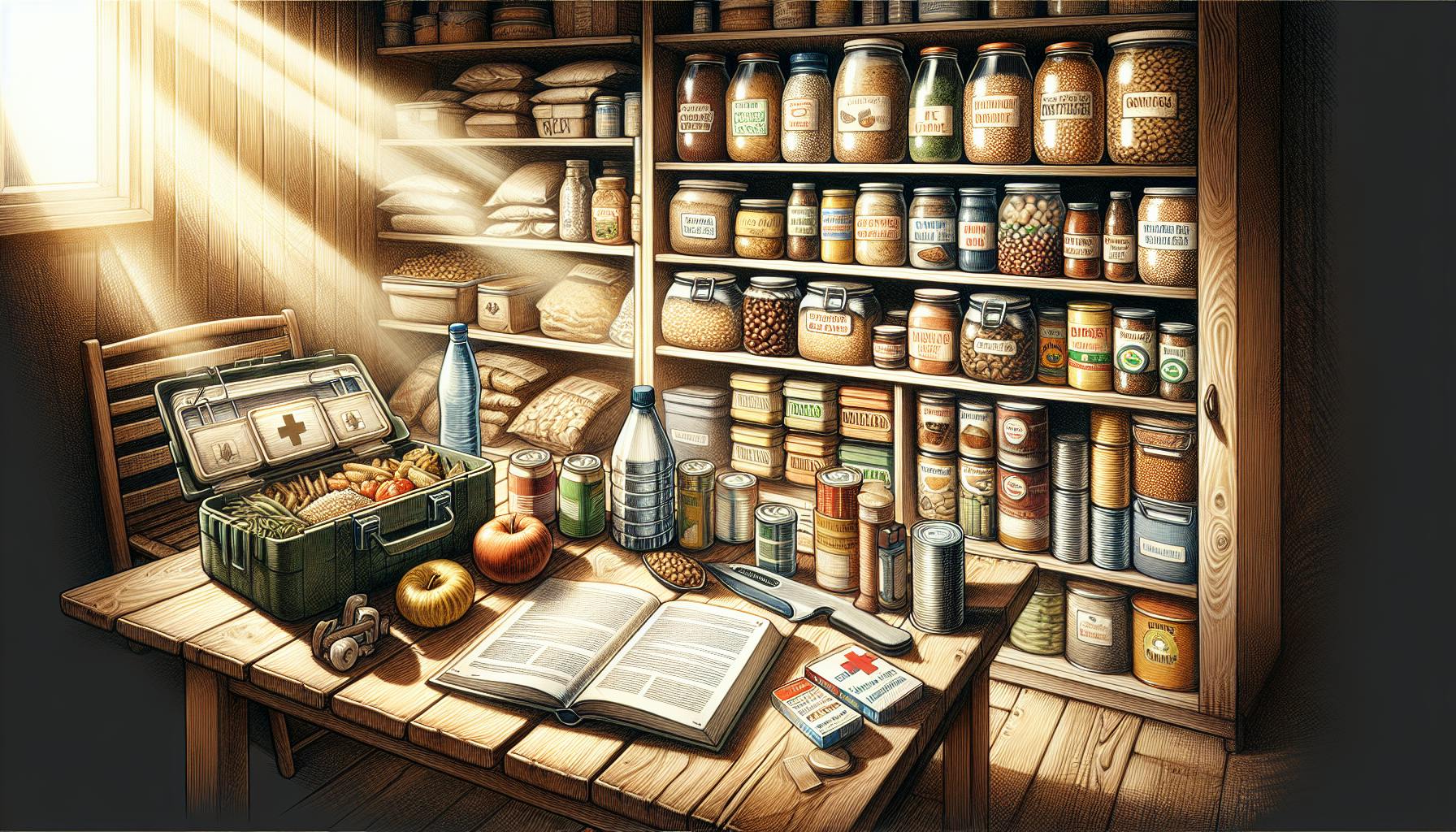Introduction
Having an emergency food supply is one of the most essential aspects of prepping and survival preparedness. When disasters strike or the power grid fails, grocery stores may be inaccessible and regular access to food is not guaranteed. This makes having reserves of shelf-stable foods critical for sustaining yourself and your family. An adequate emergency food supply provides a vital safety net in times of calamity.
But what constitutes the best emergency food supply for 2022 and beyond? With so many options from MREs to canned goods and kits, the choices can be overwhelming for preppers. Properly assessing and stocking up on food requires careful planning and consideration of key factors like nutritional balance, calories, storage, and shelf life.
At WeLovePrepping, our mission is to equip our readers with the knowledge and resources needed to become fully prepared. We provide practical, in-depth guides based on the real-world insights of experienced preppers. In this article, we will cover everything you need to know to build the ideal emergency food supply for your household's unique situation and needs in 2022.
Assessing Your Emergency Food Needs
Before you start stocking up, take time to carefully evaluate the nutritional requirements and dietary considerations of your family or group. Here are some key factors to calculate:
- Number of people you need to supply and their ages - the caloric and nutritional needs of children, adults and seniors differ
- Total calories per person required daily - recommendations range from 1500-2500 calories minimum per day for adults
- Any specialized dietary needs like food allergies, intolerances, or religious restrictions - tailor your food choices accordingly
- Recommended servings from each food group (fruits, vegetables, protein, carbs, dairy, etc.) per day - aim for nutritional balance
- Minimum days' worth you want to have on hand (start with 3-7 days then build up) - most experts recommend 2 weeks to 30 days
Canned goods and freeze dried meals have a shelf life of years, while fresh foods, snacks and MREs may last just months. Take these shelf lives into account when planning your emergency food supply and rotation system. Gradually build up your reserves until you have at least 2-4 weeks' worth of food to ride out extended emergencies.
Types of Emergency Food Options
There is a vast array of survival food types to choose from. Here is an overview of some of the most popular emergency food options and their key pros and cons:
Canned Goods
Pros:
- Nutritious options including vegetables, fruits, soups, meats and beans
- Typically last 2-5 years when stored properly
- Available at most grocery stores
- Lower cost per meal compared to other options
Cons:
- Bulky and heavy if stockpiling large quantities
- Can be high in sodium; look for lower sodium options
MREs (Meals Ready to Eat)
Pros:
- Portable, self-contained meals with entree, side, dessert & accessories
- Packed with calories perfect for emergencies
- Require no refrigeration and have a 5+ year shelf life
Cons:
- Can be expensive per meal compared to DIY options
- Known for bland taste although some brands have improved flavor
Freeze Dried Food
Pros:
- Extremely long shelf life of over 20-30 years
- Lightweight and compact compared to other emergency food types
- Just add water for preparation; no cooking fuel needed
- Improved taste over the last decade
Cons:
- Can be costly for large quantity purchases
- Texture may take some getting used to for some
Protein/Granola Bars
Pros:
- Convenient and portable
- Nutrient-dense calories perfect for emergencies
- Typically 1+ year of shelf life
Cons:
- Lack full nutritional profile of complete meal
Pros:
- Offer packaged combinations of meals and key supplies
- Simplifies the assembly process; buy in bulk
- Often include bonus items like water filters
Cons:
- Can be pricier than assembling your own custom supplies
- Contents may not suit your taste or dietary needs
When stocking up, we recommend choosing a combination of these options to create a well-rounded food supply that meets your family's unique needs and preferences.
Key Nutrients & Balancing Your Emergency Food Supply
When stocking up on emergency food, it's critical to consider nutritional balance across the key food groups. Here are some tips:
- Include whole grain starches like oats, quinoa, brown rice for fiber, vitamins, minerals and carbohydrates
- Incorporate good fats like olive oil, nuts, seeds and coconut for energy and health
- Choose high protein foods like canned chicken, tuna, salmon, turkey, beans, lentils and nut butters
- Rotate a variety of fruits and vegetables, going for lower sodium canned veggies and fruits packed in juice rather than syrup
- Factor in comfort foods like coffee, sweets and spices to boost morale
- Check labels for sodium, sugar, preservatives and nutritional content
- Have multivitamins to fill any nutritional gaps
The ideal emergency food supply should provide 2000-2500 calories and meet 100% of key vitamin, mineral and nutrition needs per person daily. Having proper nutrition reduces risk of illness and supports health, making it vital in emergency scenarios where medical care may be limited.
Proper Storage & Organization
To maximize shelf life, emergency food requires proper storage:
- Store in a cool, dry place at temperatures between 50-70°F
- Use oxygen absorbers and seal foods in Mylar bags for added protection
- Use food-grade plastic buckets or containers with tight lids to keep pests out
- Label all containers with contents and expiration or pack dates
- Organize similar items together and rotate stock using a FIFO system
- Consider shelving units and storage bins/crates to keep supplies neat and accessible
Avoid temperature fluctuations and humidity. Keeping emergency food organized makes taking inventory and rotating foods much simpler. Setting up a well-planned, maintained food storage area is a key prepper practice.
Putting It All Together - Sample 2-Week Food Supply List
Based on the guidance above, here is an example 2-week supply list for a family of 4:
- Canned goods providing 200-300 calories per serving (60-100 servings total): beans, vegetables, fruits, soups
- 30 freeze dried breakfast and entree pouches (2000+ calories)
- 20 MRE packs containing 1200+ calories each
- Protein bars (240 calories each)
- Powdered milk, oats, trail mix
- Multivitamins to fill nutritional gaps
- 6 gallons of water; water purification tablets
- Basics like oil, spices, sugar and salt
This sample supply provides over 150,000 calories total and meets core nutritional needs. Tailor your reserves to your family's unique considerations. Gradually build up variety and length to 3-4 weeks.
10 Highly Rated Emergency Food Kits & MREs for 2022
Pre-packed emergency food kits from trusted brands provide an easy way to build up your survival stockpile. Based on taste, calories, convenience and value, here are 10 top-rated options for 2022:
1. Mountain House Classic Bucket - Tasty, easy to prepare freeze dried meals for 60+ servings. Their beef stew and chicken teriyaki get rave reviews.
2. Augason Farms 30-Day Supply - Over 90,000 calories and 300 hearty servings made in the USA. Great for long emergencies.
3. Wise Company 60 Serving Entree Kit - Boil-in-pouch meals with breakfasts, lunches and dinners. Tasty variety of dishes.
4. Valley Food Storage 1 Month Supply - Well-reviewed meal pouches with bonus items like drink mixes. 25+ year shelf life.
5. Thrive Life 30 Day Food Supply - Freeze dried meals made with high-quality ingredients. Just add water.
6. Survival Frog Meal Kits - Convenient grab-and-go pouches for 3-day emergency supply. Vet designed.
7. My Patriot Supply 3-Month Emergency Food Supply - Large stockpile of meals, drinks and snacks. Made in the USA.
8. Emergency Essentials Deluxe 1 Month Food Kit - Freeze dried meals plus bonus survival items. For 2 adults.
9. MRE Depot MRE Cases - Genuine military surplus MREs. Lab-tested with 5+ year shelf life.
10. SOS Food Labs Emergency Food Bars - Portable 400-calorie meal replacement bars with a 5 year shelf life.
Be sure to research and read reviews before purchasing any emergency food kit to ensure it fits your needs.
Emergency Food Shopping Guide
Stock up on emergency food supplies through online retailers, grocery stores, warehouse clubs and preparedness expos. Here is a quick guide on key items and their shelf lives:
Canned & Jarred Goods:
- Canned fruits, vegetables, soups - 3-5 years
- Meats like chicken, tuna - 2-3 years
- Sauces, pastas, chili - 18 months-2 years
- Nut butters - 1 year unopened
Dry & Dehydrated Foods:
- Rice, grains, pasta - 30 years
- Dried beans, lentils - 30 years
- Nuts, seeds, coconut - 2 years
- Dried fruits - 25 years
Oils, Condiments & Baking:
- Vegetable, olive, coconut oils - 2-3 years
- Vinegars, soy sauce - 2-3 years
- Honey - indefinite if stored properly
- Salt, sugar - indefinite
Snacks & Comfort Foods:
- Granola, protein bars - 9-12 months
- Powdered drinks, electrolytes - 2 years
- Crackers, popcorn, jerky - 9-24 months
- Candy, chocolate - 9-12 months
Vitamins & Medicines:
- Multivitamins - 3-5 years stored properly
- Medicines - expiration on label
- Antacids - 2 years
- Anti-diarrhea - 2-3 years unopened
Rotate and replenish items as you go. Having an adequately stocked emergency pantry is a key prepper practice.
Key Takeaways
- Carefully assess your household's unique food needs and minimum viable supply duration. Aim for 2-4 weeks initially.
- Stock up on a nutritionally balanced mix of canned goods, freeze dried meals, MREs, and long shelf-life staples.
- Properly store items and rotate using FIFO for maximum freshness and shelf life.
- Consider convenient pre-packed commercial kits alongside DIY bulk items.
- Gradually build your reserves through sales, bulk purchases and multi-packs.
- Having an adequate emergency food supply is a critical prepper practice for self-reliance in disasters. Use this guide to start securing your food reserves today.
At WeLovePrepping, we provide continually updated insights and deals to help you prepare. Be sure to check out our latest emergency food kits and MRE reviews and recommendations to find the best options to feed your family in an emergency. Stay tuned for more guides on essential prepping gear and skills for emergency preparedness.


